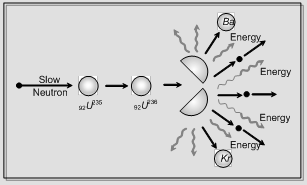Nuclear fission: The process of splitting of a heavy nucleus into two lighter nuclei of comparable masses (after bombardment with a energetic particle) with liberation of energy is called nuclear fission.
The phenomenon of nuclear fission was discovered by scientist Ottohann and F. Strassman and was illustrate by N. Bohr and J.A. Wheeler on the starting of liquid drop model of nucleus.
Fission reaction of U235
(i) Nuclear reaction:

|
(ii) The energy released in U235 fission is about 0.8 MeV or MeV per nucleon.
(iii) By fission of , on an average 2.5 neutrons are free. These neutrons are known as fast neutrons and their energy is about 2 MeV (for each). These fast neutrons can escape from the reaction so as to precede the chain reaction they are needed to slow down.
(iv) Fission of U235 occurs by slow neutrons only (of energy about 1eV) or even by thermal neutrons (of energy about 0.025 eV).
|

|
(v) 50 kg of U235 on fission will release » 4 × 1015 J of energy. This is equivalence to 20,000 tons of TNT explosion. The nuclear bomb placed at Hiroshima had this much explosion power.
(vi) The binding energy/ A of compound nucleus must be less than that of the fission products.
(vii) Most of energy released appears in the form of kinetic energy of fission fragments.
Nuclear fusion: In nuclear fusion two or more than two lighter nuclei combine to form a single heavy nucleus. The volume of single molecule so formed is less than the sum of the masses of parent nuclei. This difference in volume results in the release of tremendous amount of energy

For fusion high pressure (» 106 atm) and high temperature (of the order of 107 K to 108 K) is required and so the reaction is called thermonuclear reaction.
Fusion energy is greater than fission energy fission of one uranium atom releases about 200 MeV of energy. But the fusion of a deutron and triton free about 17.6 MeV of power. However the energy released per nucleon in fission is about 0.85 MeV but that in fusion is 4.4 MeV. So for the similar volume of the fuel, the power released in fusion is much larger than in fission.
Plasma: The temperature of the order of 108 K required for thermonuclear reactions leads to the complete ionization of the atom of light elements. The combination of base nuclei and electron cloud is called plasma. The enormous gravitational field of the sun confines the plasma in the interior of the sun.
The main problem to carryout nuclear fusion in the laboratory is to contain the plasma at a temperature of 108K. No solid container can tolerate this much temperature. If this problem of containing plasma is solved, then the large quantity of deuterium present in sea water would be able to serve as in-exhaustible source of energy.
Email based Physics assignment help - homework help at Expertsmind
Are you searching physics expert for help with Nuclear fission and fusion questions? Nuclear fission and fusion topic is not easier to learn without external help? We at www.expertsmind.com offer finest service of Physics assignment help and physics homework help. Live tutors are available for 24x7 hours helping students in their Nuclear fission and fusion related problems. We provide step by step Nuclear fission and fusion question's answers with 100% plagiarism free content. We prepare quality content and notes for Nuclear fission and fusion topic under physics theory and study material. These are avail for subscribed users and they can get advantages anytime.
Why Expertsmind for assignment help
- Higher degree holder and experienced experts network
- Punctuality and responsibility of work
- Quality solution with 100% plagiarism free answers
- Time on Delivery
- Privacy of information and details
- Excellence in solving physics queries in excels and word format.
- Best tutoring assistance 24x7 hours